|
The helmets are very attractive parts of the racing cars, perhaps in future building a model with the driver's helmet will become a common practice, like the seat belts today. Unfortunately the market does not have nowadays a wide range of helmets, in different scales, to offer to the modelers. So I scratch build these parts, which give the models a touch of personality.
The method I used to make these helmets is quite simple. It requires a master, RTV molding rubber, type t28, two-part resin and some decals.
|
The first stage
Is to prepare the master helmet and in my case I used a 1/12scale metal helmet from ONYX which is suitable as it is for helmets up to 1990, after this time the shape changed slightly, but the basic shape can be altered easily by adding filler at the back, and filing the cheek faces to suit.
|
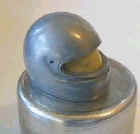
|
Stage two
Is to fix the helmet using double sided tape inside a Plasticard box to receive the rubber make sure to make the sides at least 15mm higher than the top of the helmet. I fitted four small plasticard studs in the base to act as locators because I wanted my helmets hollow, so these studs would ensure that the rubber plug I was going to make would always locate the same way for each casting.
Stage three
Is to mix the rubber with the hardener and then leave for an hour to allow the air bubbles to come out (the curing time is about 24hours) when the bubbles stop its time to pour the rubber. This should be done very slowly to avoid trapping any air around the master. Once the master is completely covered, about 10mm over the top of the dome I work a cocktail stick into the corners of the mould box to ensure the rubber tightly covers the helmet.
|
Stage four
Is to remove the solid rubber block from the box and slide it back in upside down. The four studs will have left depressions in the rubber, coat the top of the block with petroleum jelly to act as a release agent. Cut the end off a biro or similar tube and set it up in the centre of the helmet, this will form a hole in the plug through which to pour the resin. Now mix and pour some more rubber, enough to fill the inside of the helmet and to cover the upturned mould by 5mm.
|

|
|
Stage five
Should give you a two-part mould with a hole in the middle after the biro and master is removed. If you don't want the helmet hollow you can leave out stage four.
|
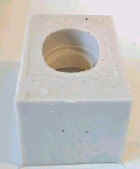
|
Stage six
Will allow the plug to be put onto the base mould ready for casting. With this type of rubber either white metal or resin can be used for casting as its high temperature RTV.
|
Stage seven
Allows you to mix resin 50/50 and pour into the mould, it cures in ten to fifteen minutes so many helmets can be made. The rubber is very tough and shouldn't tear when removing the helmet from the mould.
|
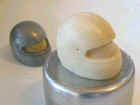
|
The final stage
Is to decorate the helmet to choice, in my case Senna and Mansell to sit with the cars in my cabinet. Any paint finish can be used as cast in either metal or resin cellulose, acrylic or enamel will work well.
|
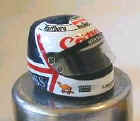
|
I found plenty of decals on the Tamiya Sheets or Studio 27. One tip I did find was that after spraying with Auto Acrylic and masking up I sprayed with tamiya acrylic, unmasked and then used a wet toothpick to trim the Tamiya paint to shape. It dissolved and could be wiped off with a tissue.
|
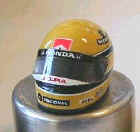
|
|